-
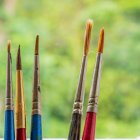 Good Quality Round Paint Brushes Can Transform Your Painting. What to Consider When Buying Round Paint Brushes and the Best Ones Currently Available in India (2021)
Good Quality Round Paint Brushes Can Transform Your Painting. What to Consider When Buying Round Paint Brushes and the Best Ones Currently Available in India (2021)
-
 Low Quality Paint Brushes Can Ruin Your Masterpiece. Check out Your Ultimate Guide to Oil Paint Brushes and the Top Oil Paint Brush Sets for Beginners Available in India (2021)
Low Quality Paint Brushes Can Ruin Your Masterpiece. Check out Your Ultimate Guide to Oil Paint Brushes and the Top Oil Paint Brush Sets for Beginners Available in India (2021)
-
 10 Best Paintbrushes for Watercolor That Will Inspire Your Creativity and Reward You with a Superior Painting Experience (2021)
10 Best Paintbrushes for Watercolor That Will Inspire Your Creativity and Reward You with a Superior Painting Experience (2021)
Understand the Anatomy of a Brush
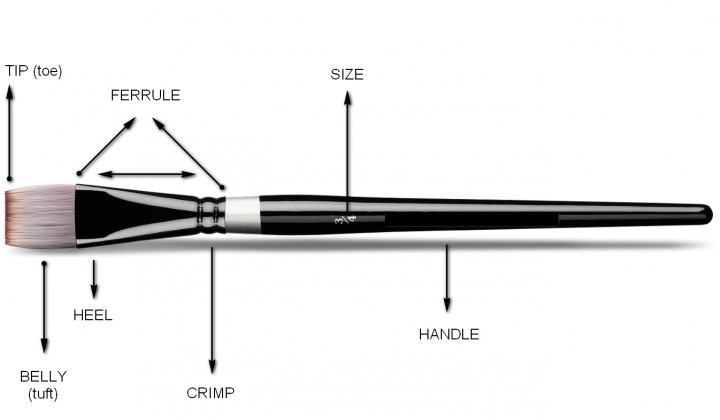
A brush is the most essential tool for an artist, as that's what he uses to portray his feelings on canvas. Brushes are for a painter what a sword is for a fighter or a saw is for a carpenter. In this article, we’ll try to understand and explore the various paint brushes that are meant for different strokes, all key for creating that next masterpiece. But first, let’s know a bit about the different attributes of a brush. The basic parts of a brush include:
- Handle – It’s from where you hold the brush and it is made from varnished wood or plastic and the length can be short or long. The wooden handles are lacquered to protect them from water, paint, etc. to avoid swelling, warping, or cracking of the wood. Brushes with wooden handles shouldn’t be left in water, else the lacquer will crack which will allow the water to enter inside the brush and eventually destroy your brush.
- Ferrule – A ferrule connects the handle to the bristles and is usually made of metal. It keeps the brush hair in good shape and a good quality ferrule wouldn’t come loose or rust. The size measurement of a brush is also done on the basis of the width of the ferrule.
- Bristles – The hair of a brush that hold and apply the colour on the base. A good quality brush has firmly held synthetic or natural bristles that don’t fall out while you’re using the brush, as that may mess up the painting when you try to remove those hair from the art. Natural hair brushes, also known as sable brushes are generally made from animal hair and are good absorbents. Natural hair bristles can be used for water, oil, or acrylic paints and work well on canvas or paper, while synthetic ones are good for hard surfaces like ceramics, clay, etc.
- Crimp – It’s that part of the ferrule that protects it with the handle.
- Heel – The upper part of the ferrule that keeps the bristles in shape by squeezing them.
- Belly – The wide part of the bristles near the ferrule. It’s the middle area in a round brush.
An Artist Needs to Stock Different Types of Brushes
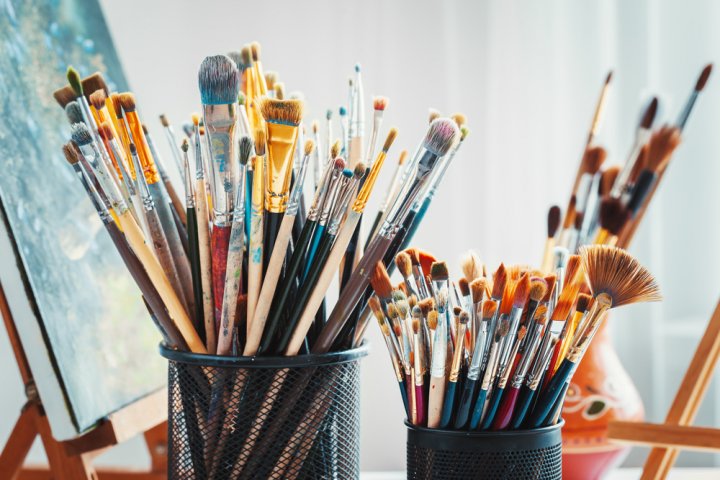
If you’re a budding artist and using brushes of different sizes without knowing the significance of each brush, chances are that you may not get the desired results from your hard work. Every little stroke and fine detailing in a painting may require a different type of brush. If you use both watercolours and acrylic paints, then use different sets for them as watercolours and paints have a different type of chemical composition, use different mediums like water and oil and thus react differently with the bristles of a brush.
Indeed, watercolour brushes, acrylic brushes, and oil paint brushes have different types of construction. Also, if your watercolour brush is made of soft hair, then avoid using it for acrylic or oil paints as the viscosity and drying time of acrylic and oil paints are different than that of watercolours. Moreover, the harsh substances in acrylic or oil paints can damage the soft bristles of a natural hair brush. So, ensure that you’re using a good quality hair brush if you’re planning to use the same set of brushes for water as well as acrylic colours.
Types of Acrylic Paint Brushes
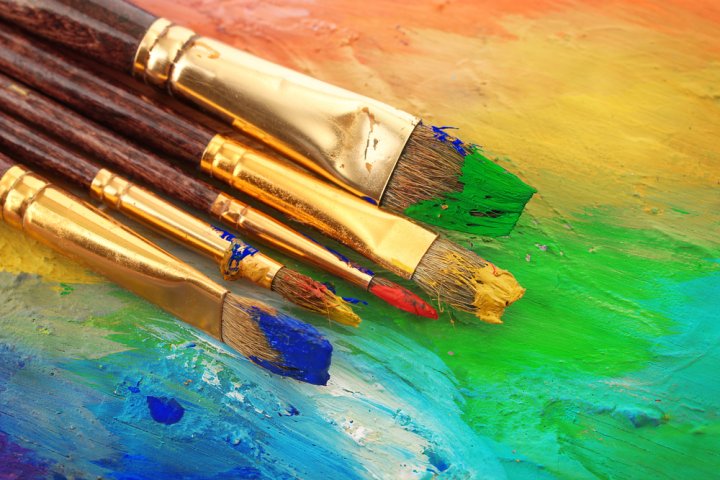
Acrylic Paint Wash Brush:
These are very big brushes that are used for quickly covering large parts of a paper or canvas. If you purchase an acrylic paint brush-set, then the biggest and thickest brush is most likely the wash brush. You can dip it directly into the paint or also use a little water to lighten the paint and cover a larger area in a single stroke. The bigger bristles also allow you to pick-up any extra paint off the base paper or canvas.Acrylic Paint Flat Brush:
As the name suggests, an acrylic paint flat brush is flatter and thinner that helps you to create wide strokes and covering bigger areas. This brush closely resemble a wash brush but is less thick and less rounded at the edges. An acrylic paint flat brush is useful in places where a wash brush may be too big. Moreover, when used tactfully, it can be used to draw fine lines.Acrylic Paint Angled Brush:
Also known as a "slanted brush" due to the slanted or angled tip, this brush helps you to do the tiny nuances in your painting. This brush is useful for making curves or lines and shapes of different thickness and coverage. It provides you the flexibility of drawing from thin to thick and is beneficial if you are new artist learning to paint on an easel.Acrylic Paint Round Brush:
An acrylic paint round brush is generally much smaller than the angled or flat brush and provides you excellent control while filling various details in your painting due to its soft and rounded edge. The narrow design of a round brush often gives you the feel of holding a pen or pencil. It is easier to hold as the design of this brush also allows you to have complete control over the flow and size of the strokes. You can experiment with both wet and dry paints using this brush for different effects.Acrylic Paint Fan Brush:
You’ll be surprised to see how beautifully and easily you can paint grass, greenery, trees, and even different water bodies with a fan brush. Blend backgrounds, colour skies, play with different textures, or add subtle highlights to the dark background; you can play along with different strokes, taps, etc. to get various amazing effects by using an acrylic paint fan brush.Acrylic Paint Liner Brush:
As the name suggests, a liner brush is a thin brush that resembles a round brush but is a very thin brush that can be used to draw the finer details, thin lines, and used for minute work on your canvas. You can use paint or ink to create very thin lines, add letters, numbers, or words using the minute tip of this brush. Many artists use this brush to sign their artwork. The acrylic paintbrush is best used wet as the paint flows more smoothly and covers a greater distance when dipped in water or oil, but can also be used with just plain paint.Acrylic Paint Palette Knife:
Technically speaking, a paint palette knife is not a brush, but still a very popular and effective way to apply paint on paper or canvas. Used by many artists to create a variety of textures, effects, and strokes in their artwork, a palette knife is available in plastic as well as metal versions. As a beginner you can use the plastic one and later on you can upgrade to a metal palette knife. Palette knives are available in many different shapes that can help you to play with a variety of strokes and designs.
Types of Oil Paint Brushes
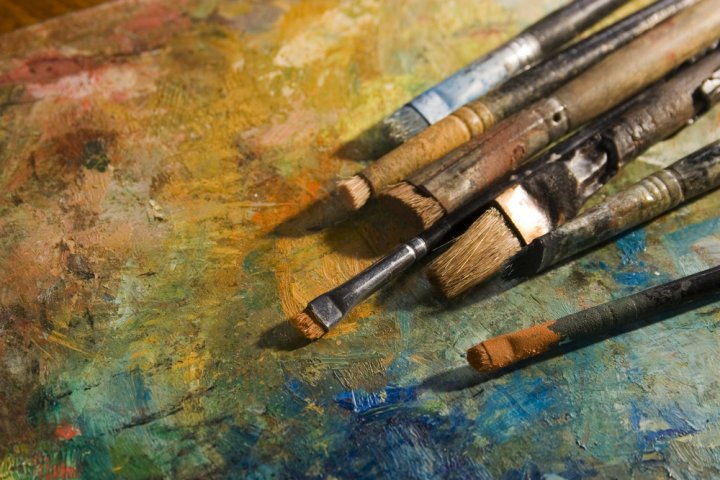
Flat Oil Paint Brush:
The flat, long and somewhat rectangular brush hair allow you to carry more paint per load, thus you can cover a larger area in one go. This type of brush is especially useful when carving smooth edges or making sweeping strokes as relatively thin lines can be drawn when held flat against the paper or canvas. They are sometimes described in measurements like ¼“, ½“, etc. while some brushes mention size as 0000, 00, 0 till 24 with the thickness and the length of the brush increasing along with the numbers.Round Oil Paint Brush:
The round oil paint brush provides less versatile strokes as it doesn't vary while you sweep it on the canvas. However, this is the quality required in a brush when you are painting details. Smaller round brushes are more appropriate for oil paintings as the tips can be used for detailing while the middle part can easily spread paint over large areas. The numbers printed on these brushes reflect the size of the brush but better to be aware of while choosing one as different manufacturers may have different numbering arrangements.Filbert Oil Paint Brush:
A filbert oil paint brush is a mix of flat and round brushes with properties of both the brushes. It’s a flat brush that is neither rectangular nor pointed but has an oval-shaped end to the bristles. This brush is also available from minute to big sizes and is really useful for producing all sorts of effects, including blending of skin tones in a portrait or different colours in a scenery.Rigger Oil Paint Brush:
A rigger oil paint brush is similar to a liner brush with thin bristles and a very pointed head that can be used to paint ultra-thin lines, draw texts, symbols, letters and even to sign beneath your painting.
Types of Watercolour Brushes
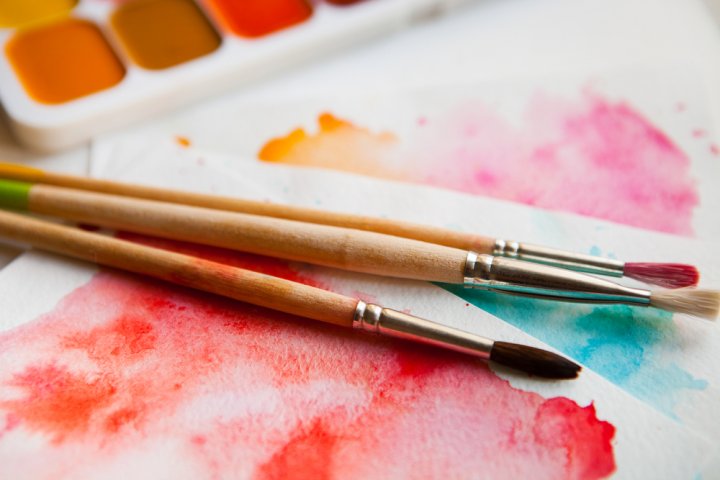
Round Watercolour Brush:
For the new artists among you who are trying out watercolour painting for the first time, a round watercolour brush is the most popular option. This type of brush can not only make a variety of broader strokes, but also fine lines and straight edges. While large round brushes can be used for washes (covering a large area with little effect), the smaller round brushes are good for detailing. Check if the brush has a good point while buying it by dipping it in clean water and flicking it steadily. The numbers may go from 0000 to 24 as the size of the brush increases.Rigger Watercolour Brush:
A rigger watercolour brush is almost similar to the rigger oil paint brush, the only difference is that the watercolour brush has more soft and natural bristles that are more compatible with watercolours. This brush was originally invented by artists to draw the ropes and rigging of ships, and since then it’s known as a rigger brush. Useful for fine lines, bushes, rock textures, or even strands of hairs, this type can be used to draw the minutest of the details and is available in sizes 00000, 000, 00, 1, 2, 4, and 6.Flat Watercolour Brush:
Like flat oil colour brushes, the flat watercolour brushes are kind of rectangular shaped brushes that are meant to draw straight edges or to fill in colour quickly as they have good colour holding capacity in a single stroke. Flat brushes are measured in fractions of an inch and this measurement describes the width of the ferrule. Some of the common sizes are ⅛”, ¼”, ½”, ¾", 1” and 2”.Mop & Wash Brush:
True to their name, mop & wash brushes are meant for producing wash effects and have great covering capacity. These are the perfect brushes for loose work on paper and some sizes are capable of producing refined marks and fine lines as well. The measurement (across the width of the ferrule) varies from 000 to 2 cm.
How to Clean Paint Brushes?
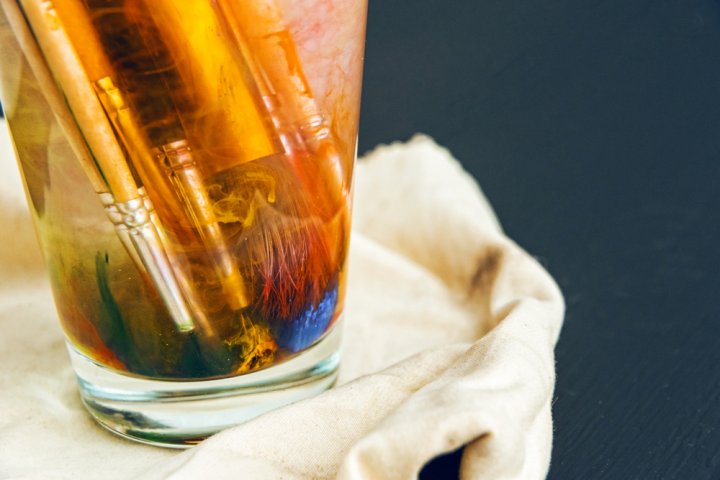
While knowing about the different types of brushes and how to use them is an important part of a painter’s life, proper cleaning and keeping the brushes safely is also essential as these are precious tools of an artist. Let’s check a few tips to clean your paint brushes to have neat and fresh paint brushes every time you start your artwork:
- Squeeze out the excess paint from the bristles by placing them between a rag or paper towel.
- Swishing the brush around in a cup of water would release any leftover paint from the bristles.
- Now get rid of the excess water by gently shaking the brush and then patting it against a soft towel.
- Repeat the above steps a few times so that most of the paint is removed.
- Now rinse your brush under a stream of lukewarm water and simultaneously, quickly and gently squeeze the bristles using your fingers to dislodge any leftover traces of paint in the bristles.
- You can also use your regular soap or a special artist soap to gently wash the hairs using your fingers by using the foam of the soap to cleanse the bristles.
- Rinse off the soap with warm water and check if any trace of paint is still left. If yes, then rinse it again until the bristles are completely devoid of paint.
- Now gently squeeze out the excess water using a rag or paper towel and let it dry in a horizontal position.
-
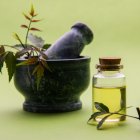 Looking for a Natural Way of Healing Your Body and Rejuvenating Your Soul? Check out the Top Books on Ayurveda to Discover and Adopt the Miracles of This Ancient System of Medicine (2021)
Looking for a Natural Way of Healing Your Body and Rejuvenating Your Soul? Check out the Top Books on Ayurveda to Discover and Adopt the Miracles of This Ancient System of Medicine (2021)
-
 Sony PlayStation Delivers the Ultimate Gaming Experience. Discover the Top PlayStation Games to Keep Your Loved Ones Enthralled for Hours (2021)
Sony PlayStation Delivers the Ultimate Gaming Experience. Discover the Top PlayStation Games to Keep Your Loved Ones Enthralled for Hours (2021)
-
 Get Inspired by the Father of the Nation: Check out the Top Books on Mahatma Gandhi to Motivate You to Achieve Greater Humanity and Compassion in Life and Attain Inner Peace (2022)
Get Inspired by the Father of the Nation: Check out the Top Books on Mahatma Gandhi to Motivate You to Achieve Greater Humanity and Compassion in Life and Attain Inner Peace (2022)
-
 Take Your Photography to the Next Level:Pick From These Best Tripods Available in India Today(2020)!
Take Your Photography to the Next Level:Pick From These Best Tripods Available in India Today(2020)!
-
 Nail Paint Removers Play an Eminent Part in Your Beauty Regime(2021): Let Your Nail Breathe with These 10 Best Nail Paint Removers that'll Make the Entire Process an Absolute Breeze.
Nail Paint Removers Play an Eminent Part in Your Beauty Regime(2021): Let Your Nail Breathe with These 10 Best Nail Paint Removers that'll Make the Entire Process an Absolute Breeze.
Invest in High Quality Paint Brushes for Maximum Satisfaction
Even though good quality paint brushes may cost a bit more upfront but they are sure to last longer and give you more satisfaction if cleaned and maintained properly. We hope this BP Guide would have helped you discover everything there is to know about the types of paint brushes, how to clean them and to kickstart your hobby, now that you are familiar with the most important tools of painting. Share your experiences with us and stay connected for more such engaging content.

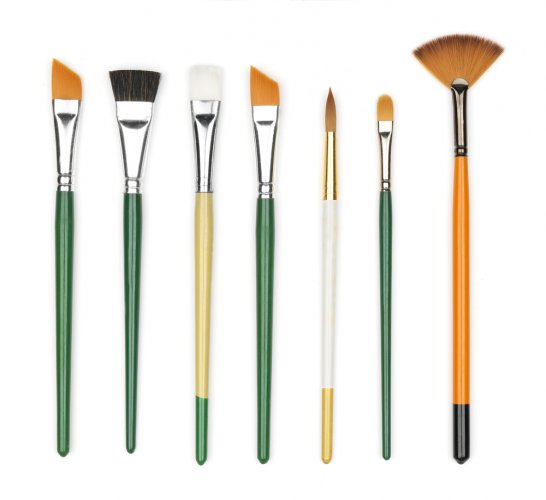
 Highlight the Best Facets of Your Incomparable Beauty: Discover the Best Face Highlighter Currently Available in India and Everything You Need to Know About Using Face Highlighters for Maximum Effect (2023)
Highlight the Best Facets of Your Incomparable Beauty: Discover the Best Face Highlighter Currently Available in India and Everything You Need to Know About Using Face Highlighters for Maximum Effect (2023)
 Forget the Blemishes and Get that Picture Perfect Flawless Radiance on Your Face: Check out the Best Foundations for Oily Skin Currently Available in India and Everything You Need to Know About Makeup Foundations (2023)
Forget the Blemishes and Get that Picture Perfect Flawless Radiance on Your Face: Check out the Best Foundations for Oily Skin Currently Available in India and Everything You Need to Know About Makeup Foundations (2023)
 Make Your Presence Felt Wherever You Go: Discover the Best Perfumes Under 2000 for Both Men and Women to Announce Your Arrival and Make Any Occasion Memorable (2023)
Make Your Presence Felt Wherever You Go: Discover the Best Perfumes Under 2000 for Both Men and Women to Announce Your Arrival and Make Any Occasion Memorable (2023)
 Protect Your Oily Skin from the Harmful Rays of the Sun: Discover the Best Gel Based Sunscreens for Oily Skin and Everything You Need to Know Before Buying One (2023)
Protect Your Oily Skin from the Harmful Rays of the Sun: Discover the Best Gel Based Sunscreens for Oily Skin and Everything You Need to Know Before Buying One (2023)
 Minor Blemishes and Wrinkles Affecting Your Confidence? Check out the Best BB Creams to Conceal Your Worries and Nourish Your Skin to Restore the Healthy, Radiant and Glowing Complexion Back Again (2023)
Minor Blemishes and Wrinkles Affecting Your Confidence? Check out the Best BB Creams to Conceal Your Worries and Nourish Your Skin to Restore the Healthy, Radiant and Glowing Complexion Back Again (2023)
